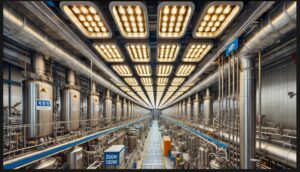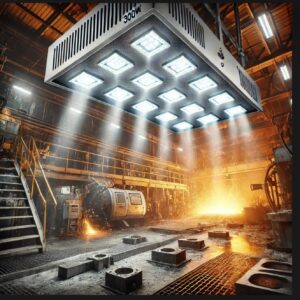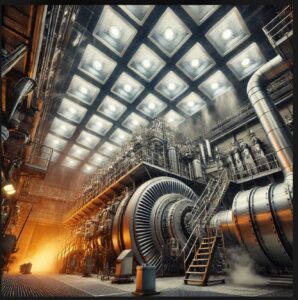3. Thermal Radiation Design
- Thermal Radiation Concept: Thermal radiation is the emission of infrared radiation (heat) from a surface as a result of temperature differences. All objects emit thermal radiation, and the amount of heat radiated increases with the temperature of the object. For LED lighting systems, thermal radiation design involves using materials and designs that maximize the dissipation of heat through radiation.
- Radiative Cooling Surfaces: To enhance thermal radiation, manufacturers use radiative surfaces that are designed to emit heat more effectively. These surfaces may include coatings or materials that have high emissivity (the ability to radiate heat). Materials such as black anodized aluminum or specialized ceramics are commonly used because they have high emissivity and can radiate heat efficiently.
- Reflective Coatings for Heat Direction: In some LED fixtures, reflective coatings are applied to direct thermal radiation away from sensitive components and toward heat sinks or other cooling areas. These coatings help to optimize the distribution of heat, preventing hotspots and ensuring that the fixture maintains a consistent temperature.
- Designing for Optimal Radiative Efficiency: Designers can optimize the geometry and surface area of the LED fixture to maximize heat radiation. For example, creating larger, flatter surfaces can increase the area from which heat can be emitted, improving the fixture’s ability to dissipate heat.
- Benefits of Thermal Radiation Design:
- Efficiency in Heat Dissipation: By maximizing the ability of the fixture to radiate heat, the lighting system can more effectively regulate temperature, even in the absence of additional cooling systems.
- Energy Efficiency: Thermal radiation design minimizes the need for additional power-consuming cooling systems, reducing overall energy use.
- Compact and Robust Design: Fixtures that rely on thermal radiation can often be more compact and durable, as they do not require bulky or mechanical components like fans.
Advanced cooling mechanisms like passive cooling, heat pipes, and thermal radiation design are essential for maintaining stable performance and safety in high-temperature LED lighting systems. These systems work together to efficiently dissipate excess heat, ensuring that LED fixtures can operate in extreme industrial environments without overheating. By incorporating these cooling technologies, manufacturers can enhance the reliability, lifespan, and energy efficiency of their lighting solutions, all while minimizing maintenance needs and improving overall operational safety.

IP and IK-rated durability for harsh industrial conditions
In industrial settings, particularly those that involve high temperatures, exposure to chemicals, dust, moisture, and physical impacts, the durability of lighting solutions is crucial. Lighting systems must be designed to withstand these demanding environments to ensure reliable performance and safety. The IP (Ingress Protection) and IK (Impact Protection) ratings are essential standards that determine how well lighting fixtures can resist elements such as dust, water, and physical impacts, making them particularly important for harsh industrial conditions. Here’s a detailed explanation of IP and IK ratings and their role in ensuring durable lighting solutions:
1. IP Rating (Ingress Protection) – Protection Against Elements
The IP rating system is used to measure the degree of protection provided by a lighting fixture against solid objects (dust, dirt) and liquid (water, oils, etc.). The rating consists of two digits:
- First Digit (Solid Object Protection): This measures the level of protection against the intrusion of solid objects, such as dust and dirt.
- Second Digit (Water Protection): This measures the degree of protection against water penetration.
Common IP Ratings for Industrial Lighting Fixtures
- IP65: Dust-tight (completely protects against dust) and protected against low-pressure water jets from any direction. This is a common rating for industrial lighting used in environments where dust and water exposure are frequent but moderate.
- IP66: Dust-tight and protected against powerful water jets (e.g., washing down equipment or rain). Ideal for environments where heavy water exposure is expected, such as food processing facilities, chemical plants, or outdoor areas in inclement weather.
- IP67: Dust-tight and protected against immersion in water up to 1 meter for up to 30 minutes. This rating is suitable for lighting used in environments prone to flooding or immersion risks, such as submerged workstations or areas with high humidity levels.
- IP68: Dust-tight and protected against continuous immersion in water beyond 1 meter. Typically used in submerged or highly humid environments, ensuring the fixture’s durability even in harsh conditions like underwater applications or areas where constant water exposure occurs.

Importance of IP-Rated Durability in Harsh Industrial Conditions
- Protection from Dust and Particles: Industrial facilities such as manufacturing plants, mines, and warehouses often deal with airborne dust and particulate matter, which can damage traditional lighting systems. IP-rated lighting fixtures ensure that dust does not infiltrate the internal components of the light, protecting sensitive electronics and extending the fixture’s lifespan.
- Water and Chemical Resistance: Industries such as food processing, chemical manufacturing, and oil & gas often require regular cleaning or operate in areas prone to spills and water exposure. IP-rated lighting ensures that the fixtures remain operational even in these environments, preventing short circuits or corrosion from water or chemical exposure.
- Operational Continuity: By choosing fixtures with appropriate IP ratings, businesses can ensure consistent illumination without the need for frequent maintenance or replacements, thus reducing downtime and operational costs.
2. IK Rating (Impact Protection) – Protection Against Physical Damage
The IK rating system is used to measure the level of protection provided by a lighting fixture against mechanical impacts (e.g., physical damage from collisions, shocks, or vibrations). This rating is important in industrial environments where lighting may be exposed to frequent physical impacts due to machinery, equipment, or heavy-duty operations.
Common IK Ratings for Industrial Lighting Fixtures
- IK07: Protection against impacts from a force of 2 joules, which is roughly equivalent to the impact of a 500g object falling from a height of 40cm. Suitable for environments where there is occasional light impact.
- IK08: Protection against impacts from a force of 5 joules, which is roughly equivalent to the impact of a 1.7kg object falling from a height of 30cm. This rating is ideal for areas with moderate risk of impact, such as warehouses and production lines.
- IK09: Protection against impacts from a force of 10 joules, roughly equivalent to the impact of a 5kg object falling from a height of 20cm. Ideal for more rugged industrial environments where heavier impacts may occur, such as heavy manufacturing or construction zones.
- IK10: The highest protection level, capable of withstanding impacts from a force of 20 joules, equivalent to the impact of a 5kg object falling from a height of 40cm. This rating is essential in high-risk environments where lighting is exposed to frequent heavy impacts, such as industrial machinery zones, high-traffic areas, or outdoor lighting exposed to vandalism.
Importance of IK-Rated Durability in Harsh Industrial Conditions
- Protection from Mechanical Damage: Industrial facilities often experience mechanical shocks or vibrations from machinery, equipment, and heavy tools. IK-rated lighting fixtures are designed to withstand these impacts, preventing breakage or internal damage to the fixture and ensuring continuous lighting.
- Vandalism Protection: In outdoor industrial environments, lighting fixtures may be exposed to potential vandalism or accidental damage. IK-rated fixtures provide added protection, ensuring that the fixtures remain functional even if subjected to physical abuse.
- Reduced Maintenance Costs: Lighting fixtures with high IK ratings are less likely to suffer damage from impact, reducing the frequency of replacements and maintenance. This results in lower costs and reduced downtime in industrial operations.

3. Combined IP and IK Protection for Industrial Lighting
In harsh industrial conditions, both Ingress Protection (IP) and Impact Protection (IK) are essential for ensuring the longevity, safety, and reliability of lighting systems. Choosing lighting solutions with appropriate IP and IK ratings helps manufacturers avoid downtime, reduce maintenance costs, and enhance safety. Some key advantages of combining these ratings include:
- Reliability in Challenging Environments: IP and IK ratings ensure that lights can withstand extreme exposure to dust, water, and mechanical impacts, making them reliable in a range of industrial environments.
- Enhanced Safety: Properly rated lighting systems contribute to worker safety by providing consistent illumination in hazardous or high-risk environments, such as those with heavy machinery or exposure to the elements.
- Sustainability and Reduced Downtime: High-rated lighting fixtures minimize the need for frequent replacements, improving operational efficiency and reducing the environmental impact of waste.
IP and IK-rated durability are essential for ensuring that lighting systems can withstand the challenges presented by harsh industrial conditions. By selecting lighting fixtures with the appropriate IP (dust and water resistance) and IK (impact protection) ratings, businesses can improve the longevity, safety, and efficiency of their lighting solutions, ensuring reliable and consistent performance in even the most demanding environments.
Customizable light output for optimized visibility in glass production areas
In industries like float glass manufacturing, where high precision and safety are paramount, the ability to customize light output in glass production areas is critical. Glass production environments require lighting that can be adapted to different stages of the manufacturing process, each with its own specific visibility needs. Customized light output allows for optimal lighting conditions that improve worker efficiency, enhance quality control, and ensure safe operations. Here’s how customizable light output benefits glass production areas:
1. Adjusting Light Intensity for Different Production Stages
- Stage-Specific Lighting Needs: Different stages of the glass production process, such as melting, forming, and cooling, require varying levels of light intensity for optimal visibility. For instance, during the initial stages when molten glass is handled, higher intensity lighting is needed to ensure safety and precision. However, during cooling or inspection, softer, diffused light is required to detect defects or inconsistencies without harsh shadows.
- LED Dimming Capabilities: Many high-quality LED systems offer dimming features that allow operators to adjust the light output based on specific tasks or stages of production. By dimming the lights in certain areas or during specific tasks, energy consumption is reduced while maintaining the appropriate visibility levels. This feature also ensures that lighting conditions are always aligned with the task at hand, providing optimal working conditions.
2. Adjustable Color Temperature for Enhanced Visual Comfort
- Color Temperature Control: The color temperature of lighting influences how workers perceive the glass and other materials. In glass production, varying the color temperature can make it easier to identify defects, texture inconsistencies, and quality issues.
- Higher Color Temperatures (5000K-6500K): Bright, cool lighting mimicking daylight is ideal for high-precision tasks and quality inspections where clarity and sharpness are essential. A higher color temperature provides clear, neutral light that reduces eye strain and enhances detail visibility in the glass surface.
- Lower Color Temperatures (3000K-4000K): Warmer light is better suited for areas that require less detailed work or to create a comfortable working atmosphere during non-inspection periods. It can also be used to reduce glare and improve visual comfort when workers are handling the materials.
- Adjustable Color Temperature Systems: Many high-quality LED lighting systems for industrial use allow for bi-color or tunable color temperature settings, enabling workers or operators to easily switch between different lighting environments as the production process changes.

3. Uniform Light Distribution for Consistent Visibility
- Eliminating Shadows and Glare: In glass production areas, shadows and glare can interfere with precise measurements, defect detection, and overall safety. Customizable light output ensures uniform distribution of light across the workspace, preventing areas of high brightness (which could cause glare) and areas of darkness (which could cause safety hazards).
- Anti-Glare and Diffusion Features: LED fixtures with diffusers or anti-glare lenses can be customized to distribute light more evenly, ensuring that glass sheets and machinery are lit consistently from every angle. This uniform lighting reduces visual strain and improves the ability to inspect glass without distraction from harsh contrasts.
(To Be Continued)



